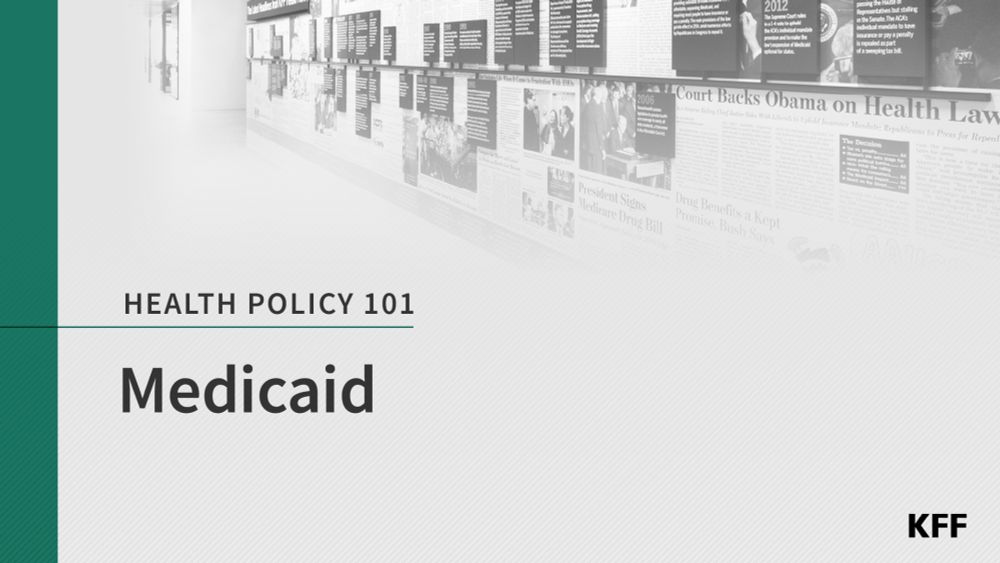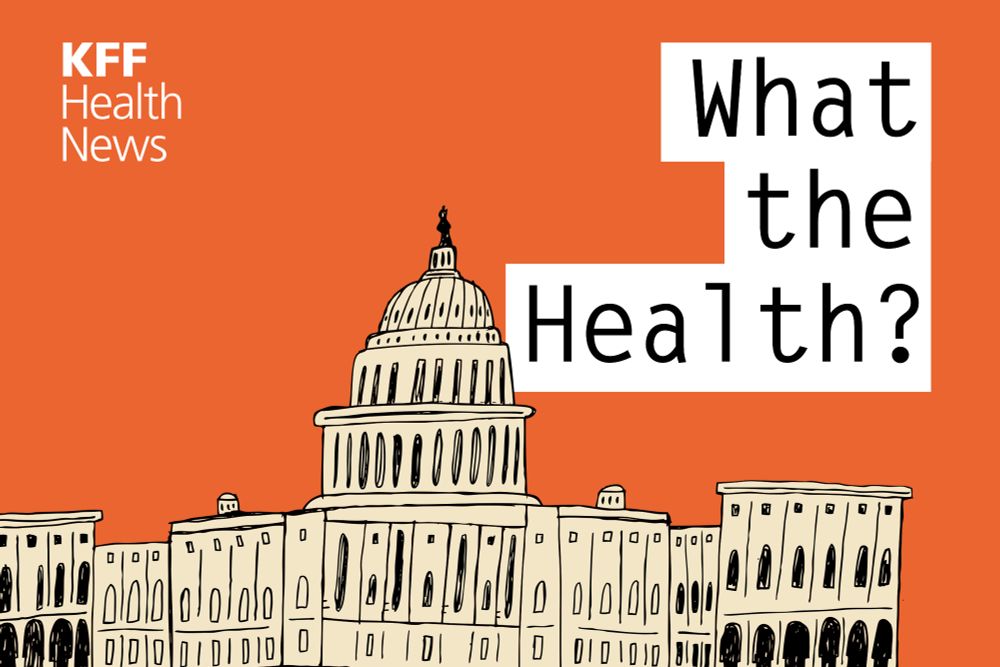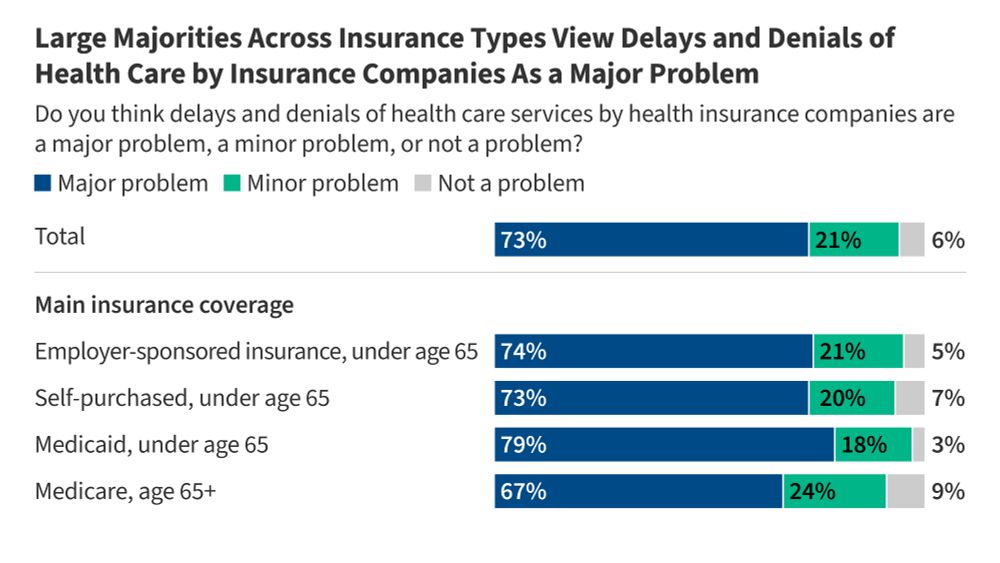As the job market stalls, remember that a major piece of the Republican tax and spending law that just passed is a work requirement for Medicaid enrollees.
01.08.2025 18:30 — 👍 76 🔁 29 💬 4 📌 0

KFF bar chart titled “Partisans, Including Among Parents, Vary in How They Describe the Impact of HHS’ Changes to Vaccine Policy; Six in Ten Democrats Say Changes Have Made People Less Safe.” The chart showing the percent of adults by party, and among parents, who think the changes to vaccine policy will make people safer or less safe, will not make a difference, or don’t know.
When asked about the impact of the changes that Secretary Kennedy is making to vaccine policy, 1 in 5 (20%) adults nationally say they are making people safer, while about a third (36%) say they are making people less safe.
More from our poll: on.kff.org/4oh9PsB
01.08.2025 17:08 — 👍 5 🔁 4 💬 0 📌 0
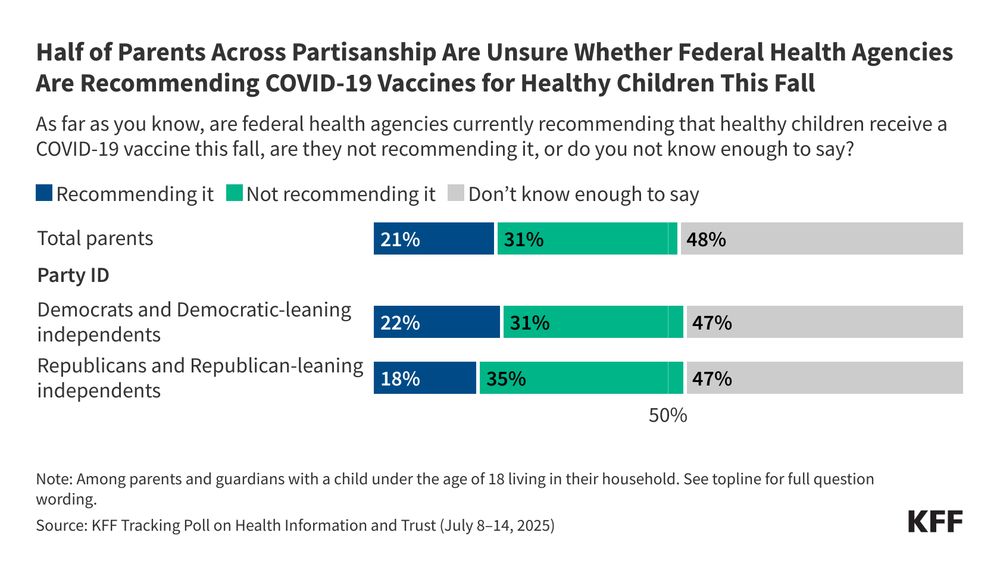
KFF chart titled “Half of Parents Across Partisanship Are Unsure Whether Federal Health Agencies Are Recommending COVID-19 Vaccines for Healthy Children This Fall.” The chart shows the percent among parents by party identification knowing whether federal health agencies are recommending the COVID-19 vaccine this fall for healthy children.
Many parents of children under age 18 are confused and uncertain about whether COVID-19 vaccines are recommended for healthy children this year.
Our poll finds about half of parents (48%) don’t know if federal agencies recommend the shot or not. on.kff.org/4oh9PsB
01.08.2025 15:04 — 👍 5 🔁 1 💬 1 📌 1
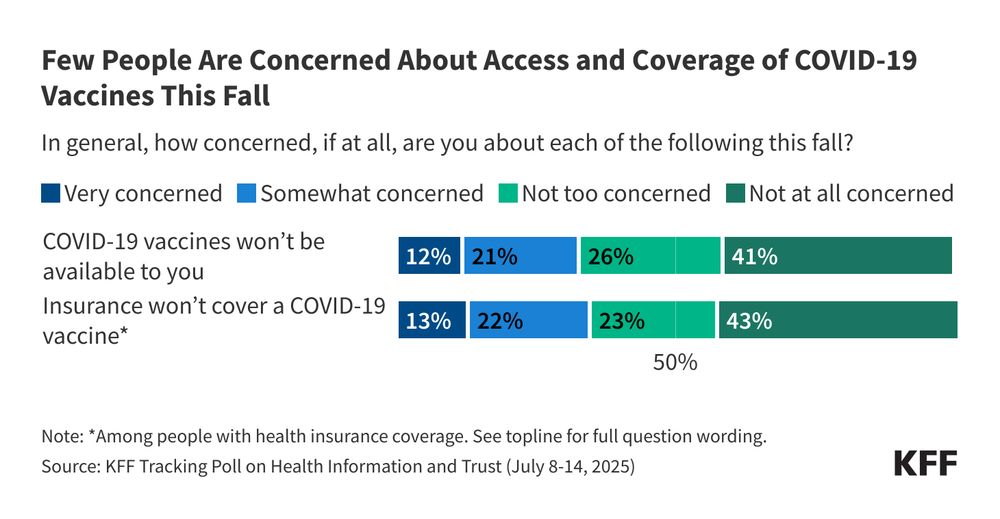
KFF bar chart titled “Few People Are Concerned About Access and Coverage of COVID-19 Vaccines This Fall.” The chart shows two bars displaying the percent of adults who are concerned the COVID-19 vaccines won't be available or that their insurance won't cover them.
Among those who plan to get the shot, two-thirds (66%) say they are concerned the vaccine won’t be available to them, and a similar share of those with insurance (62%) are concerned their insurance won’t cover the cost.
See the full report: on.kff.org/4oh9PsB
01.08.2025 13:37 — 👍 9 🔁 1 💬 2 📌 0
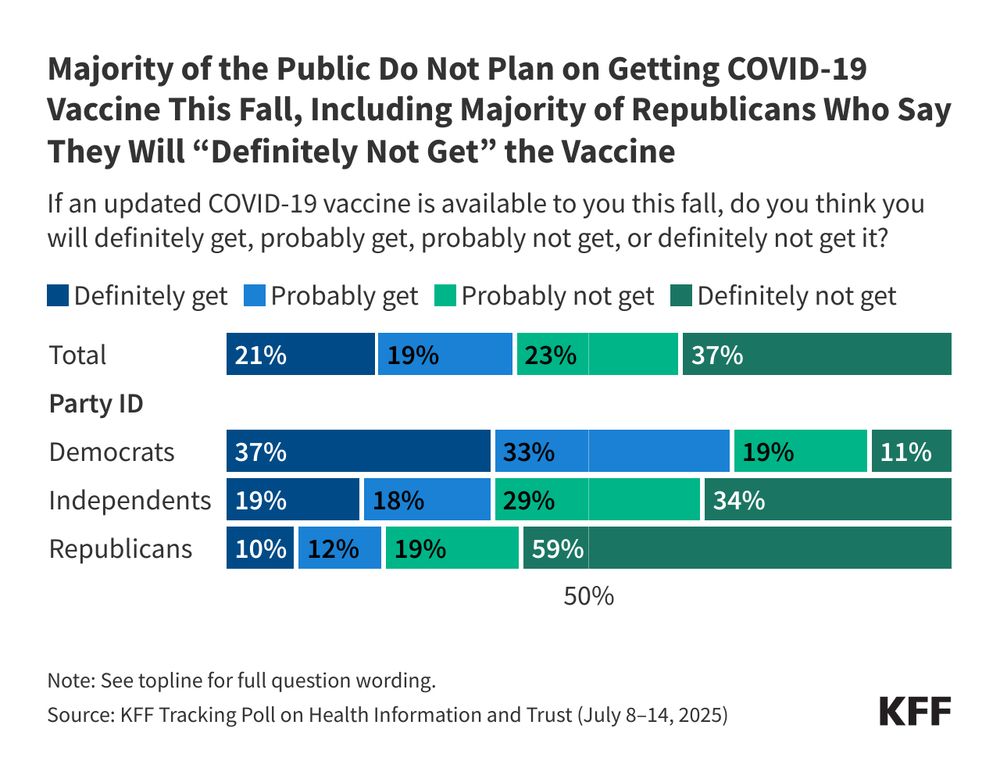
KFF bar chart titled “Majority of the Public Do Not Plan on Getting COVID-19 Vaccine This Fall, Including Majority of Republicans Who Say They Will ‘Definitely Not Get’ the Vaccine.” The chart shows the share of adults who will get the COVID-19 vaccine by total adults and party ID.
The decision to get the COVID-19 vaccine falls along partisan lines, with 70% of Democrats saying they’ll “probably” or “definitely” get the shot, while 59% of Republicans say they will “definitely not” get the vaccine.
01.08.2025 13:37 — 👍 8 🔁 1 💬 1 📌 0

KFF bar chart titled “Majority of the Public Do Not Plan on Getting COVID-19 Vaccine This Fall, Including Majority of Republicans Who Say They Will ‘Definitely Not Get’ the Vaccine.” The chart shows the share of adults who will get the COVID-19 vaccine by total adults and party ID.
As federal vaccine policy changes, our latest poll finds most (59%) adults don’t expect to get a COVID-19 vaccine this fall, while four in 10 (40%) say that they will “definitely” or “probably” get the shot.
01.08.2025 13:37 — 👍 6 🔁 1 💬 3 📌 1
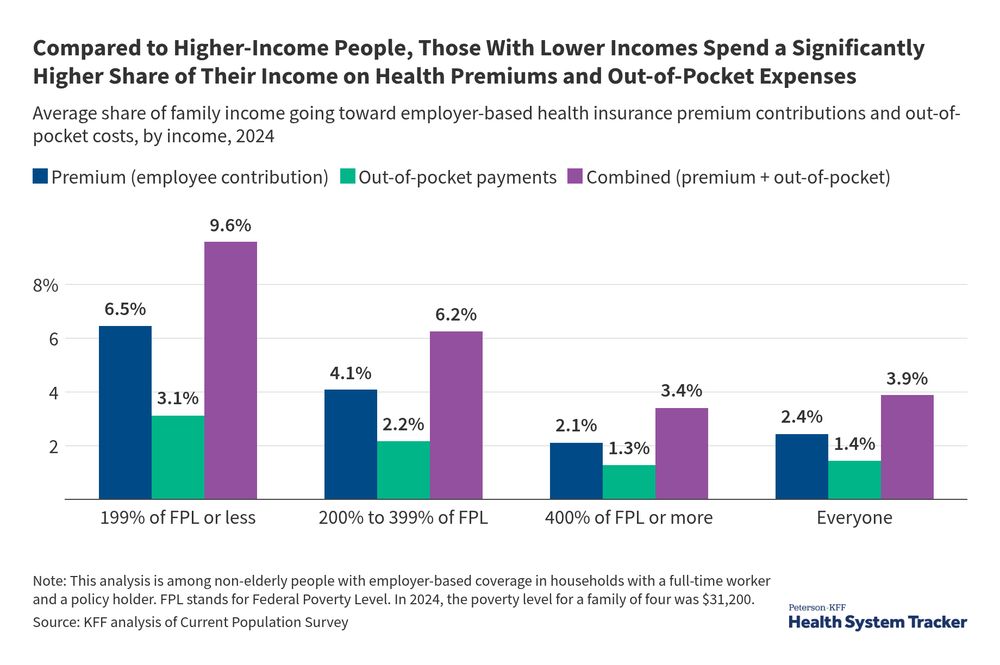
KFF-Peterson bar chart titled “Compared to higher-income people, those with lower incomes spend a significantly higher share of their income on health premiums and out-of-pocket expenses.” The chart shows the average share of family income going toward employer-based health insurance premium contributions and out-of-pocket costs, by income, in 2024, for 199% federal poverty level or less, 200%-399% of federal poverty level, 400% of federal poverty level or more, and everyone.
Our new analysis looks at the share of family income that people with employer-based coverage pay toward their premiums and out-of-pocket payments for medical care.
Hint: Those with less income pay a higher share: on.kff.org/476hFPF
31.07.2025 21:36 — 👍 8 🔁 4 💬 1 📌 0

KFF-Peterson bar chart titled “Compared to higher-income people, those with lower incomes spend a significantly higher share of their income on health premiums and out-of-pocket expenses.” The chart shows the average share of family income going toward employer-based health insurance premium contributions and out-of-pocket costs, by income, in 2024, for 199% federal poverty level or less, 200%-399% of federal poverty level, 400% of federal poverty level or more, and everyone.
People in lower-income families with employer coverage spend more of their incomes on health costs than those with higher incomes, and the cost — including premiums, deductibles, and other out-of-pocket costs — has risen steadily over time: on.kff.org/476hFPF
31.07.2025 17:26 — 👍 11 🔁 6 💬 0 📌 1

KFF bar chart titled “Medicare Advantage Enrollment by parent organization, 2025.” The chart shows the breakdown of total Medicare enrollment in 2025: 34.1 million. UnitedHealth Group Inc. is 29% (9.9 million); Humana Inc. is 17% (5.7 million); CVS Health Corporation is 12% (4.1 million); Elevance Health Inc. is 7% (2.2 million); Kaiser Foundation Health Plan Inc. is 6% (2.0 million); and all other parent organizations are 30% (10.3 million).
Medicare Advantage enrollment is highly concentrated among plans owned by a few firms, with UnitedHealth Group leading the market, and, together with Humana, accounting for nearly half (46%) of all Medicare Advantage enrollees nationwide, similar to 2024. on.kff.org/3U0UkHF
31.07.2025 15:05 — 👍 6 🔁 0 💬 0 📌 0
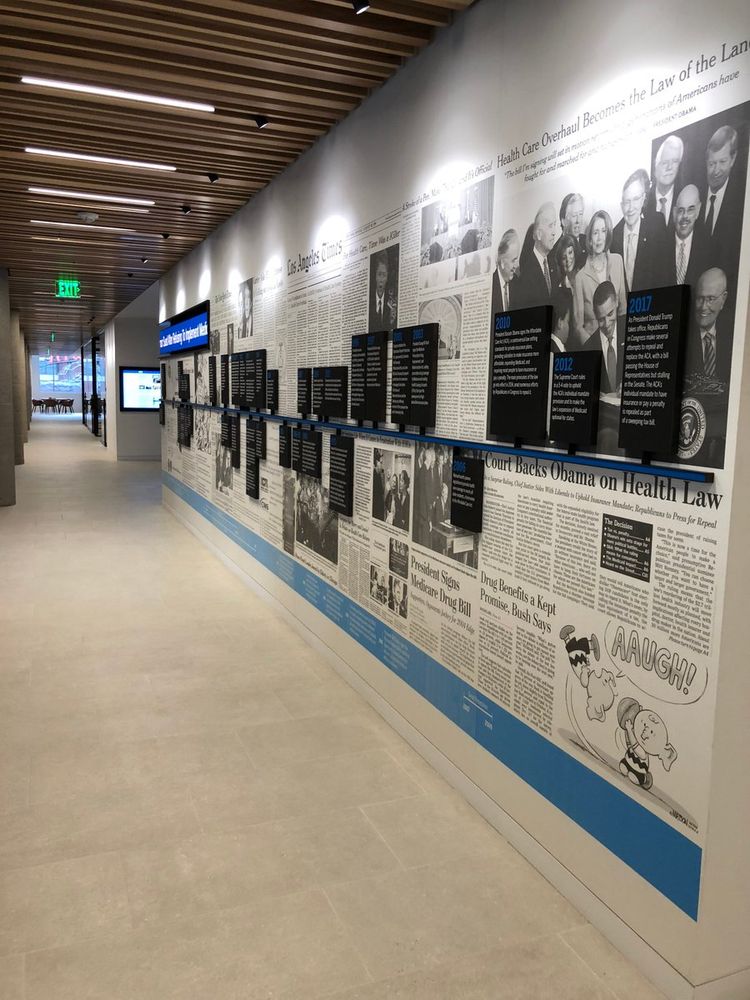
Medicare and Medicaid were created 60 years ago today. Medicaid now covers more people than Medicare. But, when we created this timeline for @kff.org's San Francisco headquarters, we couldn't find any news headlines from 1965 that mentioned Medicaid.
30.07.2025 15:24 — 👍 103 🔁 24 💬 2 📌 3

Measles Elimination Status: What It Is and How the U.S. Could Lose It | KFF
The United States is at risk of losing its measles elimination status. This post looks at what measles elimination means, how the current measles outbreak threatens this status, and what losing it…
As vaccine skepticism escalates and the number of U.S. measles cases grows, we examine what it means to eliminate measles, whether the current measles outbreak could threaten the country’s measles elimination status, and what losing that status might mean.
30.07.2025 18:36 — 👍 9 🔁 2 💬 0 📌 0
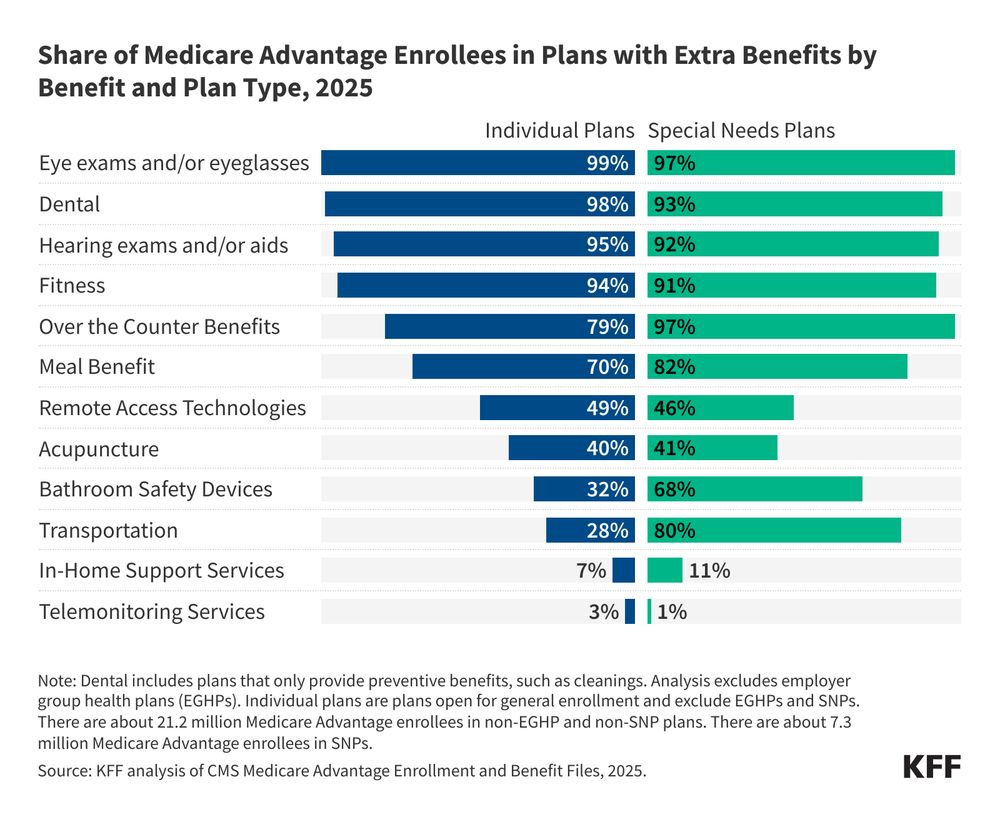
KFF bar chart titled “Share of Medicare Advantage enrollees in plans with extra benefits by benefit and plan type, 2025.” The chart shows the difference between individual plans and special needs plans for eye exams and/or eyeglasses; dental; hearing exams and/or aids; fitness; over the counter benefits; meal benefit; remote access technologies; acupuncture; bathroom safety devices; transportation; in-home support services; telemonitoring services.
Most Medicare Advantage enrollees, including enrollees in special needs plans (SNPs), are in plans that offer some benefits not covered by traditional Medicare, such as vision, hearing and dental. on.kff.org/4kYSLor
30.07.2025 17:42 — 👍 4 🔁 1 💬 2 📌 0
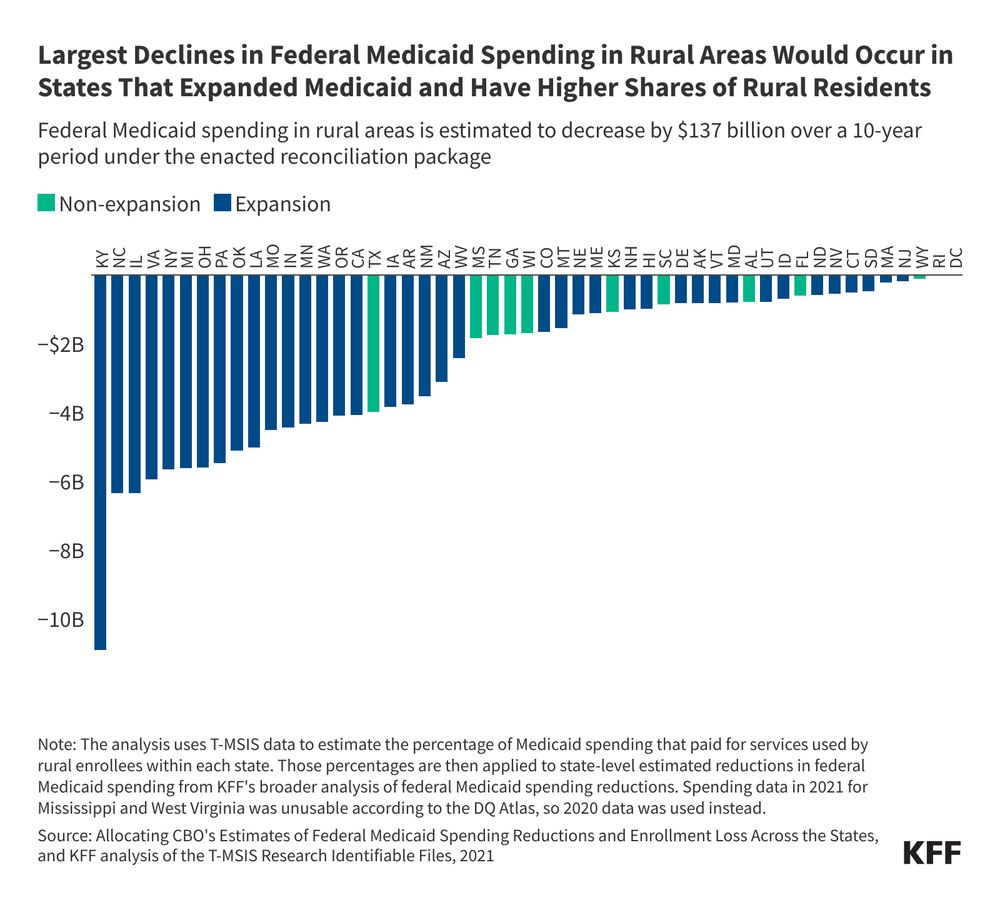
KFF bar chart titled “Largest Declines in Federal Medicaid Spending in Rural Areas Would Occur in States That Expanded Medicaid and Have Higher Shares of Rural Residents.” The chart shows the expected federal Medicaid spending decreases per state — both expansion and non-expansion states — under the reconciliation law.
Over half of the tax and budget law’s federal Medicaid spending cuts in rural areas are in 12 states with large rural populations and expanded Medicaid under the ACA.
Kentucky would lose the most, with an estimated drop of nearly $11 billion over 10 years. on.kff.org/45fuHrP
30.07.2025 14:57 — 👍 17 🔁 12 💬 0 📌 0

KFF stacked bar chart titled “Distribution of Medicare Advantage Enrollment, 2010-2025).” The chart shows the breakdown of special needs plans, employer/union-sponsored group plans, and individual plans, open for general enrollment. In 2025 the breakdown was 21% (special needs plans); 17% (employer/union-sponsored group plans); and 62% (individual plans, open for general enrollment).
In 2025, one in five (21%) Medicare Advantage enrollees is in a special needs plan (SNP), reflecting a steady increase in recent years.
Nearly half of the total increase in Medicare Advantage enrollment between 2024 and 2025 was among SNPs: on.kff.org/3U0UkHF
30.07.2025 13:30 — 👍 4 🔁 2 💬 0 📌 0
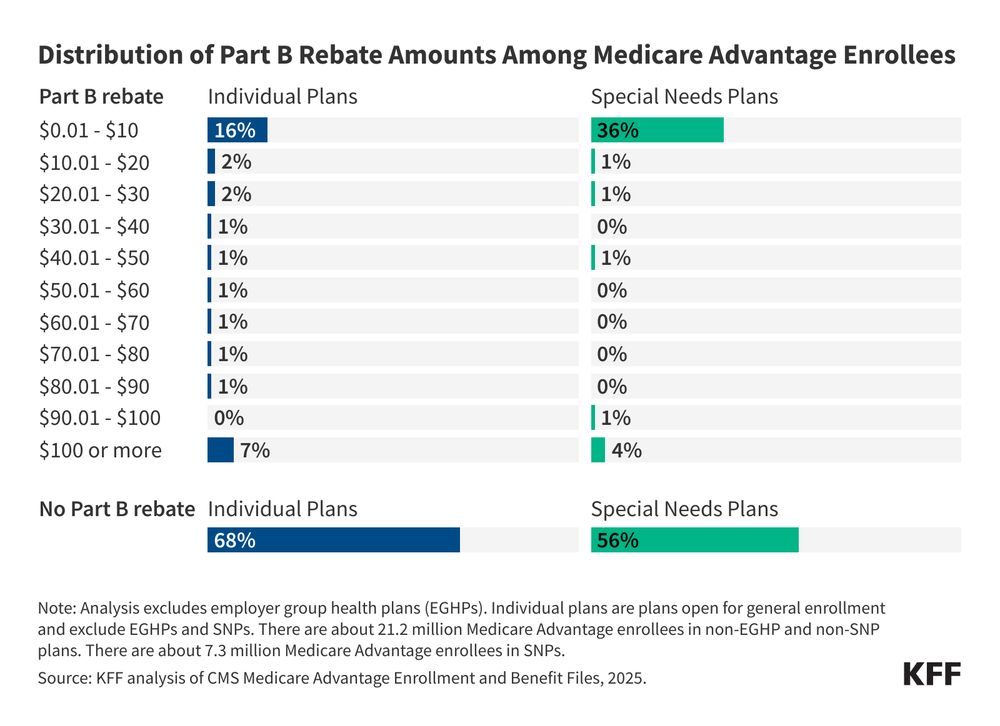
KFF bar chart titled “Distribution of Part B rebate amounts among Medicare Advantage enrollees.” The chart shows the breakdown between Part B rebates and no Part B rebates for individual plans and special needs plans.
In 2025, 32% of Medicare Advantage individual plan enrollees were in plans that offer a Part B rebate, up from 12% in 2024.
Although such rebates are often used in Medicare Advantage marketing, for most enrollees the dollar value of the rebate is small. on.kff.org/4kYSLor
29.07.2025 21:43 — 👍 4 🔁 0 💬 1 📌 0

Measles Elimination Status: What It Is and How the U.S. Could Lose It | KFF
The United States is at risk of losing its measles elimination status. This post looks at what measles elimination means, how the current measles outbreak threatens this status, and what losing it…
In the first half of 2025, the U.S. has had more measles cases, outbreaks, affected states, and deaths than in any year since 1992.
Our new brief breaks down what that could mean for the U.S.’ status as a country that had eliminated endemic measles.
29.07.2025 20:11 — 👍 17 🔁 3 💬 0 📌 1
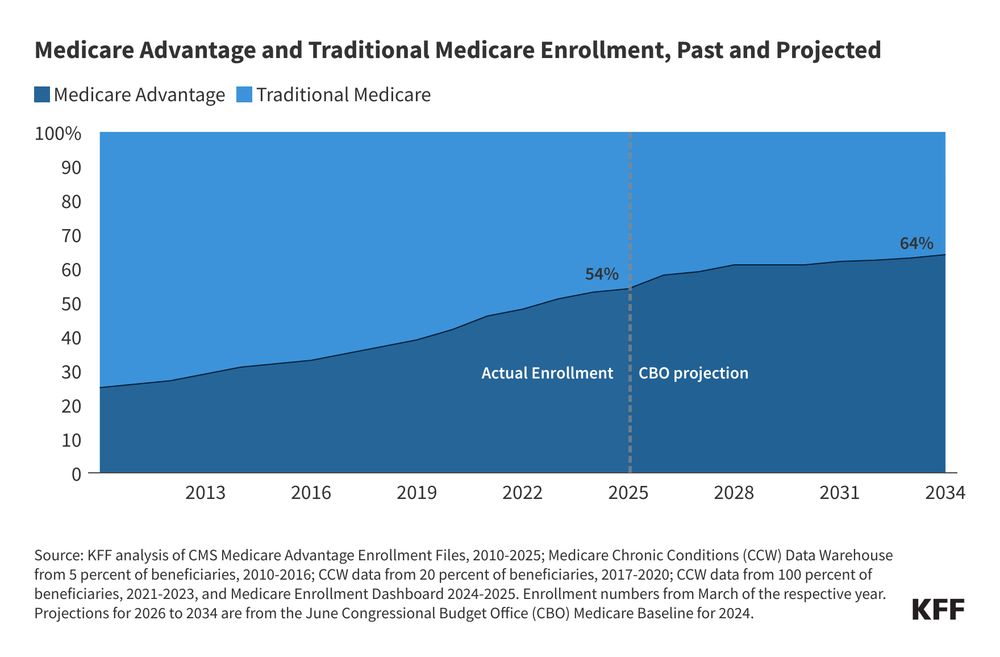
KFF chart titled “Medicare Advantage and Traditional Medicare enrollment, past and projected.” It shows actual enrollment (54%) in 2025 and CBO projection (64%) for 2034.
In 2025, more than half (54%) of Medicare beneficiaries with both Medicare Parts A and B — 34.1 million out of about 62.8 million — are enrolled in Medicare Advantage plans.
The Congressional Budget Office projects that the share will rise to 64% by 2034: on.kff.org/3U0UkHF
29.07.2025 19:00 — 👍 3 🔁 0 💬 0 📌 0
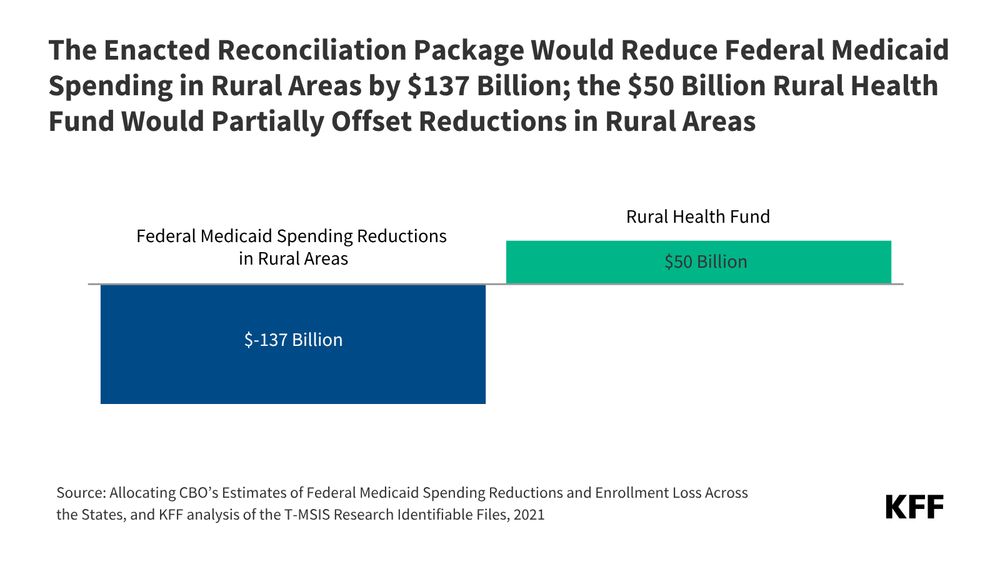
KFF bar chart titled “The Enacted Reconciliation Package Would Reduce Federal Medicaid Spending in Rural Areas by $137 Billion; the $50 Billion Rural Health Fund Would Partially Offset Reductions in Rural Areas” The chart shows the reconciliation package signed into law last month would reduce federal Medicaid spending in rural areas by $137B, while the rural health fund would add only $50B.
Under the reconciliation package signed into law last month, federal Medicaid spending in rural areas is estimated to fall by $137 billion.
That is far more than the $50 billion appropriated for the rural health fund. on.kff.org/45fuHrP
29.07.2025 18:20 — 👍 9 🔁 2 💬 1 📌 0

KFF donut chart titled “Distribution of Medicare Advantage prescription drug plan (MA-PD) enrollees, by premium, 2025. The average premium for 2025 is $13 per month. MA-PD enrollees in individual plans is 20.4 million. 76% have no premium; 4% less than $20 per month; 12% $20-49 per month; 6% $50-$99 per month; 3% $100+ per month.
In 2025, 76% of enrollees in individual Medicare Advantage plans with prescription drug coverage pay no premium other than the Part B premium.
That is a big selling point for beneficiaries, particularly those living on modest incomes and savings. on.kff.org/4kYSLor
29.07.2025 17:46 — 👍 7 🔁 1 💬 1 📌 0
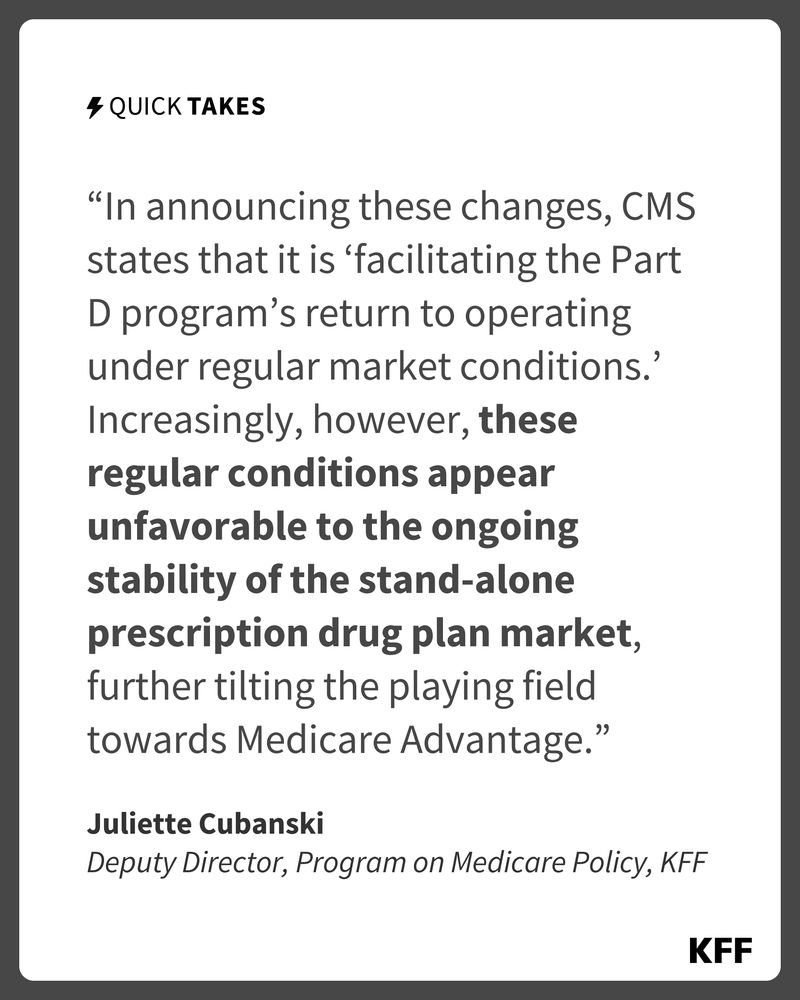
KFF graphic featuring a quote from Juliette Cubanski, KFF Deputy Director, Program on Medicare Policy. It says, “In announcing these changes, CMS states that it is ‘facilitating the Part D program’s return to operating under regular market conditions.’ Increasingly, however, these regular conditions appear unfavorable to the ongoing stability of the stand-alone prescription drug plan market, further tilting the playing field towards Medicare Advantage.”
⚡ KFF’s @jcubanski.bsky.social writes about upcoming changes to the Part D premium stabilization program. It will continue for another year under the Trump administration, but with reduced support to stand-alone drug plan sponsors in 2026. #QuickTake on.kff.org/46Q1QNd
29.07.2025 13:22 — 👍 7 🔁 0 💬 0 📌 0
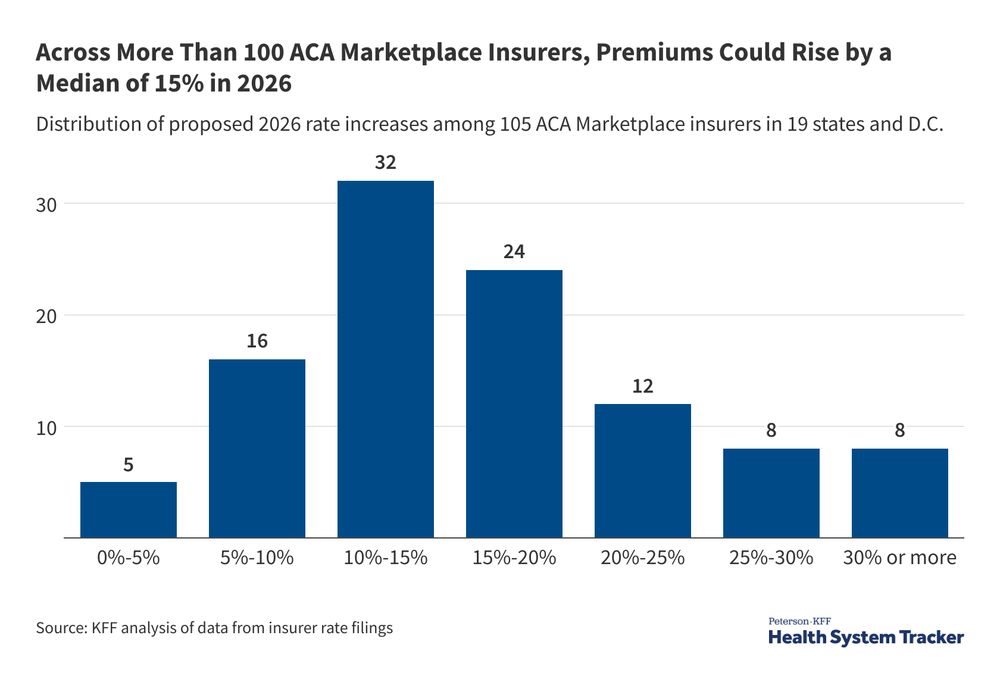
KFF bar chart showing the distribution of proposed 2026 rate increases among 105 ACA Marketplace insurers in 19 states and D.C. The chart shows that the median proposed increase is about 15%.
ACA Marketplace insurers are proposing the biggest premium increases since 2018 — a median jump of 15%, per our analysis.
They cite rising health care costs, the expected expiration of enhanced tax credits, and the impact of tariffs as key factors: on.kff.org/3TIMVwq
28.07.2025 17:31 — 👍 9 🔁 7 💬 0 📌 0
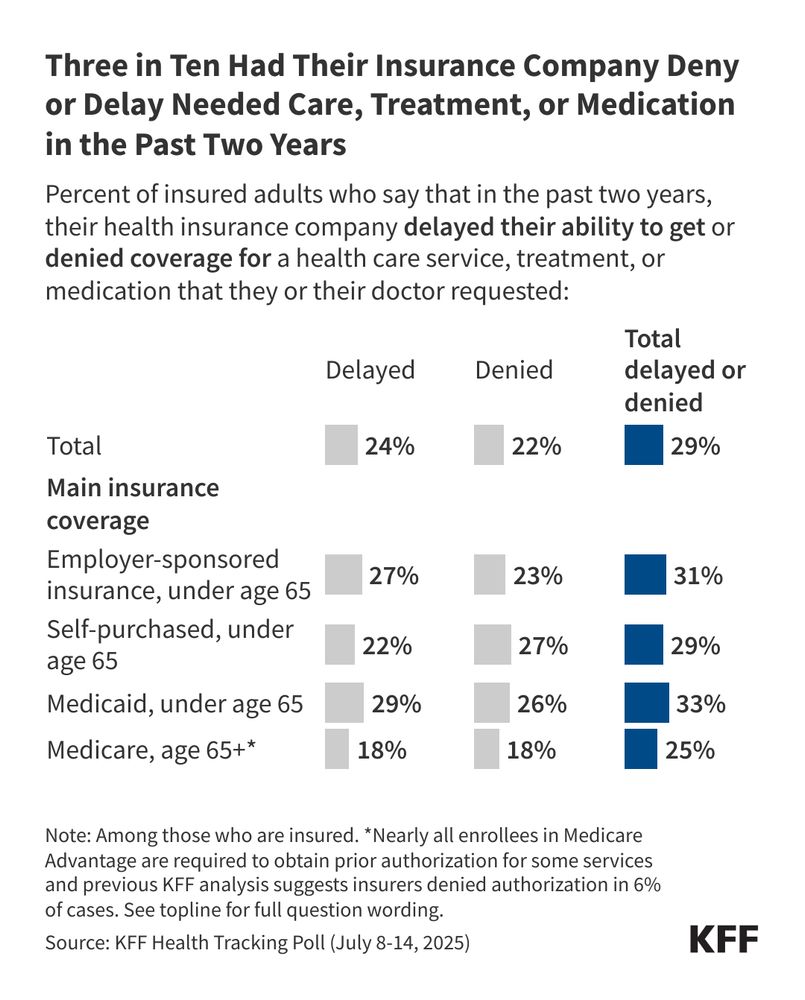
Split bar chart showing the share of insured adults who have experienced a delay, denial, and both. Results shown by type of insurance coverage. The chart shows Three in Ten Had Their Insurance Company Deny or Delay Needed Care, Treatment, or Medication in the Past Two Years.
About half of insured adults say that their insurer has required them to get prior approval before getting a service, treatment or drug that they needed in the past two years. Many report denials or delays in getting care.
More from our poll: on.kff.org/3GT9dZA
28.07.2025 13:20 — 👍 13 🔁 5 💬 2 📌 0
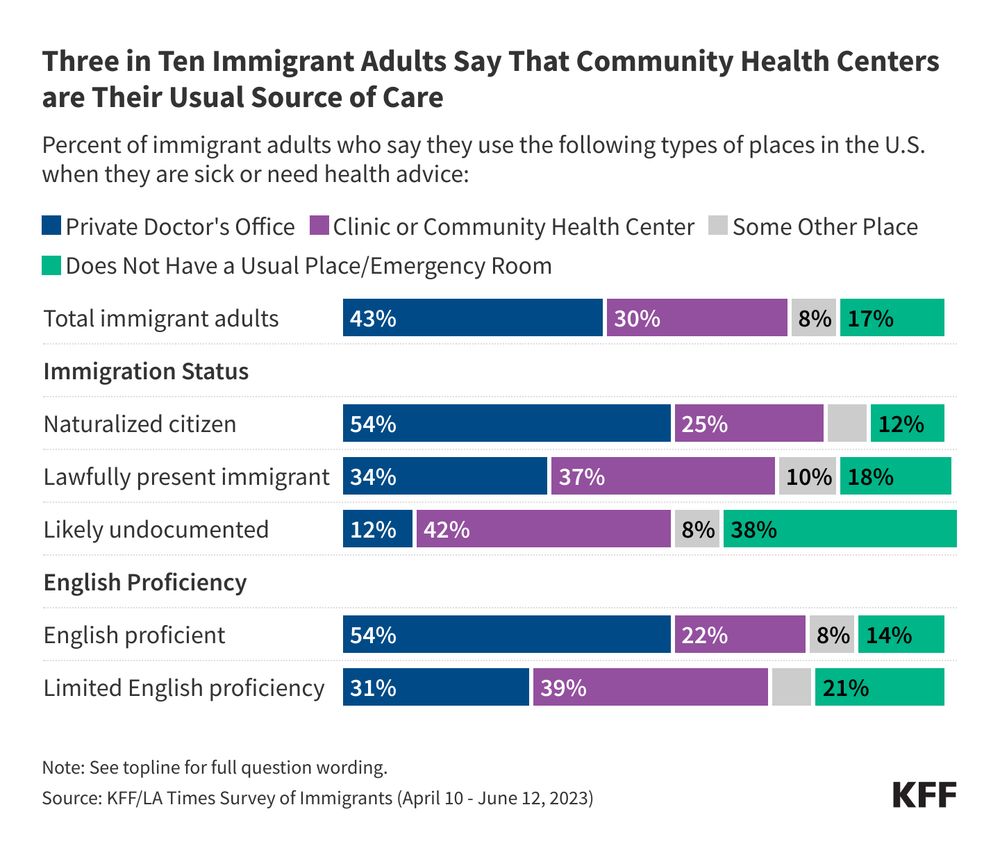
Bar chart from KFF titled 'Three in Ten Immigrants Adults Say They Use a Community Health Center as Their Usual Source of Care'. It shows the percentage of immigrant adults using various healthcare facilities in the U.S. Categories include Private Doctor's Office, Clinic or Community Health Center, Some Other Place, and Does Not Have a Usual Place/Emergency room. Data is broken down for total immigrant adults, by immigration status and by English proficiency.
A recent HHS policy change will bar many groups of lawfully present immigrants as well as undocumented immigrants from accessing many health care, educational, and other social services — including community health centers, where many immigrants get care. on.kff.org/3GZHma5
25.07.2025 20:48 — 👍 4 🔁 1 💬 1 📌 1
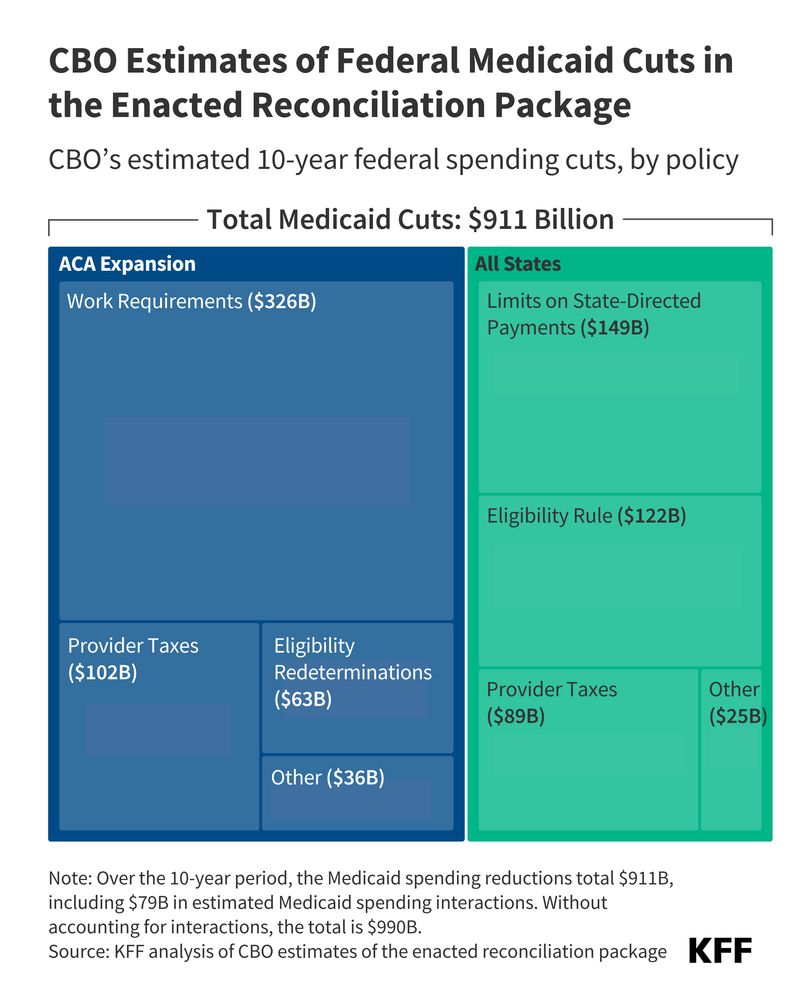
Chart from KFF showing CBO’s estimated 10-year federal spending cuts by policy in the budget reconciliation package, which will cut federal Medicaid spending by an estimated $911 billion. The tree map chart splits the spending cuts by type and policy area, including ACA Expansion (work requirements, provider taxes, eligibility redeterminations, and other) and all states (eligibility rule changes, limits on state-directed payments, provider taxes, and other).
On July 4, President Trump signed into law a budget reconciliation package that will cut federal Medicaid spending by an estimated $911 billion over 10 years, per CBO’s latest data.
The cuts represent 14% of federal spending on Medicaid over this period: on.kff.org/46VjNK4
25.07.2025 18:30 — 👍 7 🔁 3 💬 0 📌 1

KFF bar chart showing the distribution of proposed 2026 rate increases among 105 ACA Marketplace insurers in 19 states and D.C. The chart shows that the median proposed increase is about 15%.
Subsidized ACA enrollees are mostly insulated from premium increases because tax credits tie their costs to their income.
But enhanced tax credits are set to expire later this year, and costs will jump for many unless Congress renews them. on.kff.org/3TIMVwq
25.07.2025 17:08 — 👍 2 🔁 3 💬 0 📌 0
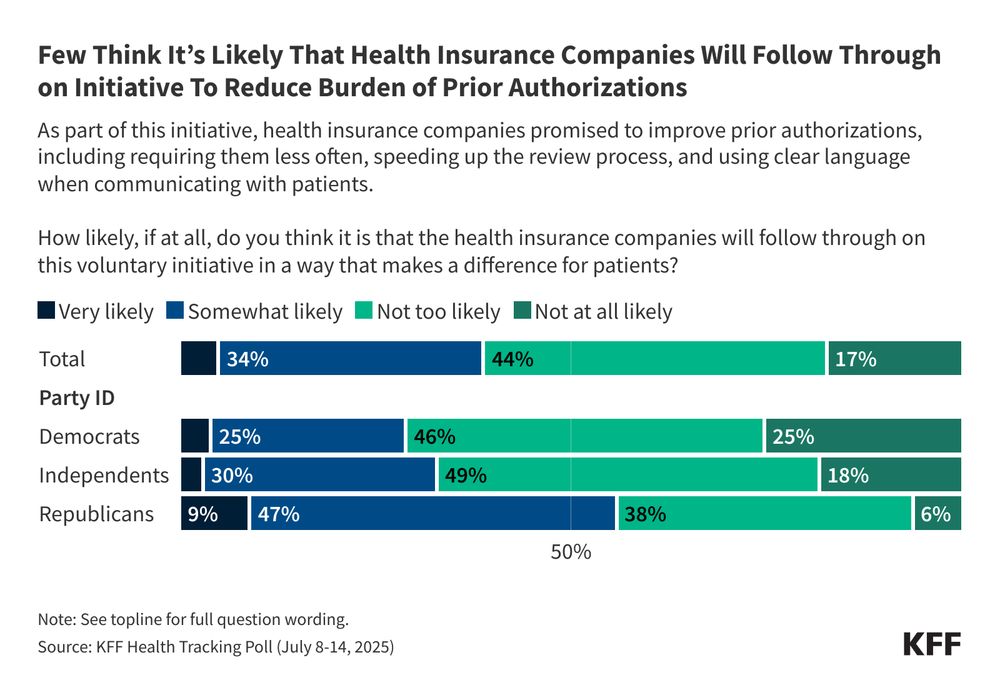
Stacked bar chart showing likely the public believes insurance companies will follow through on the newly announced initiative. Results shown by party. The chart shows Few Think It’s Likely That Health Insurance Companies Will Follow Through on Initiative To Reduce Burden of Prior Authorizations.
Last month, health insurers joined HHS leaders to launch a new voluntary effort to reduce the burden of prior authorization.
Our latest poll shows few are aware of the effort. When told about it, most are skeptical it will make a difference for patients: on.kff.org/3GT9dZA
25.07.2025 15:04 — 👍 5 🔁 2 💬 0 📌 1
President and CEO of @kff.org; Executive Publisher of @kffhealthnews.org
Associate Director, Global Health Policy, @KFF.org. Focused on global health policy and financing. Occasionally think about soccer and food.
@KFF.org EVP, COO & Exec Director, Public Opinion & Survey Research
Long-term care researcher at KFF
Editor for Broadcast at KFF Health News. Stories on NPR, Marketplace, CBS radio, and in your podcast feed! Before: NPR’s Up First and Morning Edition. Some time ago: finished my anthro PhD without falling into any Dead Sea sinkholes, but it was close.
⚡️(Newly) award-winning illustrator at KFF Health News; definitely a cat person. 🐈⬛ Find my work at: https://kffhealthnews.org/news/author/oona-tempest/
Polling at KFF. Talk to me about the state of Maine, survivor/love island, or (my) cats.
Public Opinion Survey Analyst, KFF
https://www.kff.org/polling/
Research Assistant at KFF (Kaiser Family Foundation)
Senior Vice President / Executive Director, Social Impact Media @KFF.org
Reposts ≠ endorsements
Associate Director @KFF.org researching #HealthPolicy. Focus on #Medicaid, #Long-TermCare, and policies related to people with a #disability. Love to talk data and what we can learn as data access and processing improves.
Reporter @KFFHealthNews.bsky.social covering mental health & substance use. Teaching safe suicide reporting. Dessert lover & permanent dance student. Tips: anerip@kff.org
Writing about abortion, guns, insulin, trans health care and the Midwest for KFF Health News
Signal: Brambo.11
Ethnic Media Editor with KFF Health News. Ex ETL/TWP, PAHO. Passions: infectious diseases, Latino health, movies, books, mythology. (Foto: CDC. 1961. Laboratory technicians conducting a plague study.)
Senior Correspondent, KFF Health News. Former Wall Street Journal senior health reporter. Email tips to stephaniea@kff.org
VP and Director, Racial Equity and Health Policy, @KFF.org
#Healthpolicy analysis focused on racial health disparities and immigrant health and well-being
Director, LGBTQ Health Policy; Assoc. Director, HIV Policy @KFF.org
Writing & thinking about health access & data related to #HIV and #LGBTQ+ health policy.
Associate Director, Racial Equity & Health Policy; Director, Immigrant Health Policy @KFF.org
PhD from George Washington University
MPH from Emory University
BS from The Ohio State University















